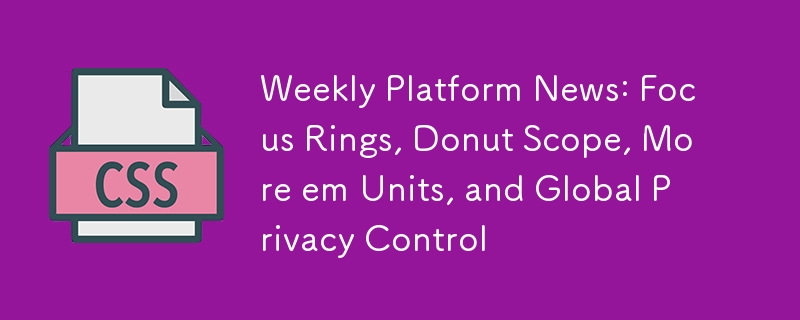 Web Front-end
Web Front-end
 CSS Tutorial
CSS Tutorial
 Weekly Platform News: Focus Rings, Donut Scope, More em Units, and Global Privacy Control
Weekly Platform News: Focus Rings, Donut Scope, More em Units, and Global Privacy Control
Weekly Platform News: Focus Rings, Donut Scope, More em Units, and Global Privacy Control

This week's web development news covers significant updates across various platforms. Key highlights include Chrome's handling of focus rings, the enhanced capabilities of the CSS :not() selector, major adoption of Global Privacy Control (GPC), and a compelling argument for em-based media queries. We also explore a CSS solution to improve form validation styling.
Chrome's Focus Ring Behavior Changes
Chrome, Edge, and other Chromium-based browsers currently display focus rings on button clicks. This differs from Safari and Firefox, which only show focus rings when keyboard navigation is used. Developers have employed workarounds using data-whatintent and :focus-visible to manage this behavior. However, Chrome 90 will eliminate the need for these workarounds by changing its user agent stylesheet to prioritize :focus-visible, thus suppressing focus rings on clicks and taps while preserving them for keyboard users.
Leveraging CSS :not() for "Donut Scope" Selection
The A:not(B *) selector pattern allows selecting all A elements not descended from B. Expanding this to A B:not(C *) creates a "donut scope," enabling precise selection of elements within a specific context, excluding those within a nested element. For example, article p:not(blockquote *) selects all paragraphs within an article, excluding those inside blockquotes.
Global Privacy Control Gains Traction
Global Privacy Control (GPC), a legally enforceable privacy signal using the Sec-GPC: 1 header, signals user preference against data sharing or sale. The New York Times is the first major publisher to fully support GPC, with others like The Washington Post and Automattic pledging support shortly. When a GPC signal is detected, compliant sites will cease sharing user data (excluding service providers) where relevant privacy laws apply.
The Advantages of em-Based Media Queries
Websites using pixel-based font sizes (font-size: 20px) are unresponsive to browser-level font size adjustments. Using em and rem units allows responsiveness to user preferences. For consistent behavior, media queries should also use em units (e.g., min-width: 80em). This ensures responsive layouts adapt correctly even when users adjust their default font size, preventing issues like excessively short lines in multi-column layouts. A PostCSS plugin simplifies the conversion from px to em in media queries.
Improving Form Validation Styling with :user-invalid
The standard CSS :invalid pseudo-class has limitations in form validation. It triggers on every keystroke and immediately on page load for required fields, potentially causing a confusing user experience. The :user-invalid pseudo-class, already supported in Firefox as :-moz-ui-invalid, addresses these issues by only applying after significant user interaction. Efforts are underway to standardize :user-invalid across other browsers.
The above is the detailed content of Weekly Platform News: Focus Rings, Donut Scope, More em Units, and Global Privacy Control. For more information, please follow other related articles on the PHP Chinese website!

Hot AI Tools

Undresser.AI Undress
AI-powered app for creating realistic nude photos

AI Clothes Remover
Online AI tool for removing clothes from photos.

Undress AI Tool
Undress images for free

Clothoff.io
AI clothes remover

Video Face Swap
Swap faces in any video effortlessly with our completely free AI face swap tool!

Hot Article

Hot Tools

Notepad++7.3.1
Easy-to-use and free code editor

SublimeText3 Chinese version
Chinese version, very easy to use

Zend Studio 13.0.1
Powerful PHP integrated development environment

Dreamweaver CS6
Visual web development tools

SublimeText3 Mac version
God-level code editing software (SublimeText3)

Hot Topics
 Vue 3
Apr 02, 2025 pm 06:32 PM
Vue 3
Apr 02, 2025 pm 06:32 PM
It's out! Congrats to the Vue team for getting it done, I know it was a massive effort and a long time coming. All new docs, as well.
 A bit on ci/cd
Apr 02, 2025 pm 06:21 PM
A bit on ci/cd
Apr 02, 2025 pm 06:21 PM
I'd say "website" fits better than "mobile app" but I like this framing from Max Lynch:
 Can you get valid CSS property values from the browser?
Apr 02, 2025 pm 06:17 PM
Can you get valid CSS property values from the browser?
Apr 02, 2025 pm 06:17 PM
I had someone write in with this very legit question. Lea just blogged about how you can get valid CSS properties themselves from the browser. That's like this.
 Using Markdown and Localization in the WordPress Block Editor
Apr 02, 2025 am 04:27 AM
Using Markdown and Localization in the WordPress Block Editor
Apr 02, 2025 am 04:27 AM
If we need to show documentation to the user directly in the WordPress editor, what is the best way to do it?
 Stacked Cards with Sticky Positioning and a Dash of Sass
Apr 03, 2025 am 10:30 AM
Stacked Cards with Sticky Positioning and a Dash of Sass
Apr 03, 2025 am 10:30 AM
The other day, I spotted this particularly lovely bit from Corey Ginnivan’s website where a collection of cards stack on top of one another as you scroll.
 Comparing Browsers for Responsive Design
Apr 02, 2025 pm 06:25 PM
Comparing Browsers for Responsive Design
Apr 02, 2025 pm 06:25 PM
There are a number of these desktop apps where the goal is showing your site at different dimensions all at the same time. So you can, for example, be writing
 How to Use CSS Grid for Sticky Headers and Footers
Apr 02, 2025 pm 06:29 PM
How to Use CSS Grid for Sticky Headers and Footers
Apr 02, 2025 pm 06:29 PM
CSS Grid is a collection of properties designed to make layout easier than it’s ever been. Like anything, there's a bit of a learning curve, but Grid is
 Google Fonts Variable Fonts
Apr 09, 2025 am 10:42 AM
Google Fonts Variable Fonts
Apr 09, 2025 am 10:42 AM
I see Google Fonts rolled out a new design (Tweet). Compared to the last big redesign, this feels much more iterative. I can barely tell the difference





